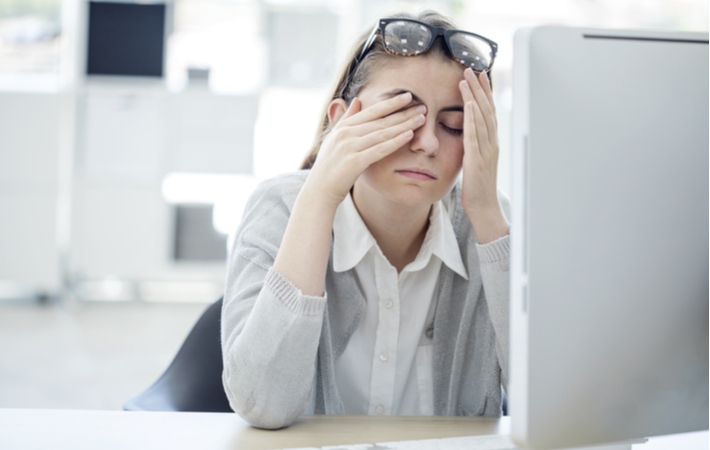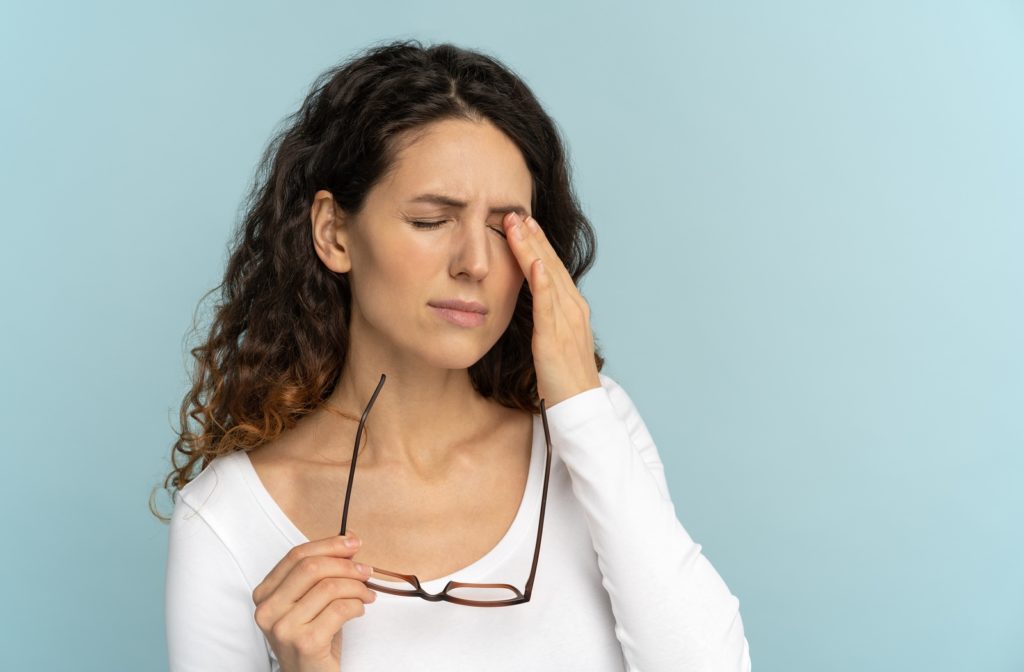Like other muscles in our bodies, our eyes can get tired after extended use. There are many reasons you can experience tired eyes. It can happen to anyone.
Fortunately, tired eyes are usually nothing to worry about and there are some easy ways you can help yourself feel more comfortable right away!
Recognizing Tired Eyes
Tired eyes are a common result of extended strain on your visual system. Tired eyes are natural and aren’t a cause for concern. Recognizing the symptoms can help you prevent strain and keep yourself comfortable.
Symptoms & Causes
The signs and symptoms of eye strain include:
- Redness
- Dry eyes
- Headache
- Eye twitching
- Heavy eyelids
- Light sensitivity
- Sore, tired eyes
- Frequent tearing
- Burning or itching
- Trouble concentrating
- Blurred or double vision
- Neck, should, or back pain
Eye strain can be caused by a number of factors, such as:
- Dry eye
- Poor lighting
- Stress or fatigue
- Harsh light or glare
- Extended screen time
- Driving long distances
- Reading without breaks
- Exposure to air conditioning
- Undiagnosed eye or vision issues
Is It Dry Eye?
What Is Dry Eye?
Dry eye is an increasingly common condition that causes your eyes to feel uncomfortable and irritated. Symptoms can be subtle at first, but if dry eye goes untreated for too long, it can impact your ability to perform daily tasks like driving or reading.
Dry eye is different from eye strain. However, eye strain is a symptom of dry eye which means they can occur simultaneously. Dry eye requires more treatment than eye strain, so it’s important to know what to look for and see your optometrist regularly.
Symptoms & Causes
Dry eye occurs when your tears are too unstable to keep the eyes properly hydrated. This can occur as a result of inadequate tear quality or tear volume. Your optometrist can test for dry eye.
The signs and symptoms to look for include:
- Redness
- Blurred vision
- Light sensitivity
- Frequent tearing
- Eye fatigue/strain
- Grittiness or scratchiness
- Difficulty nighttime driving
- Stinging or burning sensation
- Stringy mucus in/around eyes
- Trouble wearing contact lenses
The causes of dry eye include:
- Aging
- Allergies
- Dry environment
- Certain medications
- Extended screen time
- Eye conditions/diseases
Prevention & Treatment
If you experience symptoms of dry eye, or are simply looking to prevent this condition, there are a few things you can do:
- Quit smoking
- Use eye drops
- Use a humidifier
- Adjust your computer
- Use wraparound sunglasses
- Avoid air blowing in your eyes
- Take breaks during long tasks
For dry eye treatment, it’s important to see your optometrist. There are a number of treatment options available to help you conquer dry eye!

Treating Eye Fatigue
Tired eyes, eye strain, and eye fatigue; this condition can be treated at home with a few techniques that you can add to your daily routine. It’s easy and it helps your eyes relax!
Get a Good Night’s Sleep
Getting enough sleep is crucial for your overall health, but also to help your eyes rest. Sometimes it isn’t enough to prevent or treat eye strain, but it’s a great start.
Eye Drops & Compresses
Relieve eye irritation with artificial tears. Use your eye drops as directed to keep your eyes lubricated and refreshed. You can also apply a warm or cool washcloth over your eyes to help relieve eye strain.
Usually, warm compresses help with dry eye and eye strain while cool compresses can help with headaches.
20-20-20 Rule
Whenever you’re using a digital device, like your computer screen at work, follow the 20-20-20 rule. Every 20 minutes take a 20-second break to stare at something 20 feet away. This rule helps keep your eyes focused, but not worn out.
You should also try to take a short break every hour to stand up, stretch, drink some water, and give your eyes a rest.
Adjust Your Computer
You can adjust your computer set up to prevent eye strain.
Make sure your screen is positioned at eye level about 25 inches away from your face. Adjust the brightness of your monitor so it isn’t brighter than the light in the room.
Avoid hunching your back by sitting on an exercise ball or ensuring your shoulders are pulled back every time you use your 20-20-20 rule!
Try to Avoid Allergens
Whether you have seasonal or ongoing allergies, avoiding these triggers will help prevent eye strain, too. But of course, you’re probably already avoiding allergens already!
Update Your Prescription
You should see your optometrist every year to make sure your eyeglass or contact lens prescriptions are up-to-date, as well as check for any signs of eye conditions or diseases. Comprehensive eye exams can help prevent eye strain by ensuring you have the proper prescription.
We’re Here to Help
Our team at Discover Eyecare is here to help. Book an appointment with us today and stop eye strain in its tracks! You deserve to see clearly and comfortably.



